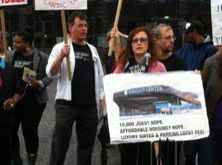Activists Protest Ratner As Barclays Center Opens

With Jay-Z scheduled to play a Friday night concert inaugurating the gleaming new Barclays Center, opponents of the project gathered to deride the new arena as a costly boondoggle that will not benefit Brooklyn.
Gathered in the shadow of the Barclays Center’s rust-colored, undulating curves, community activists said the new arena has enriched developer Bruce Ratner without yielding the promised jobs or affordable housing. Speakers called for the city of New York to conduct a new environmental impact report assessing the project’s effect on the neighborhood.
“Welcome to the tale of two Brooklyns,” Candace Carponter, a member of the organization Develop Don’t Destroy Brooklyn, said. “Behind us stands a gaudy monument to crony capitalism.”
Speakers faulted Ratner for reaping millions in tax breaks and subsidies from the city and reneging on his promises of hundreds of jobs and affordable family housing. They noted that a planned residential tower that would be the project’s first housing development contains only nine family-sized units affordable to lower-income Brooklynites.
“What we need is two-bedroom, three-bedroom units that are affordable,” said Deborah Howard, executive director of the Pratt Area Community Council. “They have skewed what is needed.”
Advocates also faulted the project for producing a little over 100 full-time jobs, far fewer than initially projected. A construction worker named Kathleen Noreiga spoke of how she initially supported the project but later changed her mind after an Atlantic Yards-sponsored job training program failed to deliver her a promised union card or construction job; she and a group of other workers are suing Ratner.
“We will not tolerate these divide-and-conquer tactics,” Noreiga said. “We were lied to again.”
The Atlantic Yards project extends beyond the Barclays Center to encompass a 22-acre site over which Forest City Ratner Developers has exclusive rights. Advocates called for the remaining undeveloped land to be split up into separate parcels that different developers can then win rights to, in a competitive bidding process.
While Carponter acknowledged there is nothing to be done about the Barclays Center, she said her organization was turning its attention to the “entire area behind this arena that is now lying fallow.”
Dan Goldstein, who founded Develop Don’t Destroy Brooklyn, said Ratner’s use of eminent domain -- something that allowed him to displace residents to make way for the development -- has shut the community out. Goldstein protested the development by refusing to move out of his home, which sat atop land the state seized in 2010.
“We were told this project was needed to stem the tide of gentrification in central Brooklyn,” Goldstein said, but given spiraling rents that Goldstein said already forced out some small businesses, “this building is a gentrification machine.”
Others directed their criticism at access to the Barclays Center itself, where the Brooklyn Nets will play beginning this NBA season. Umar Jordan, a community organizer from the Brooklyn neighborhood of Bedford-Stuyvesant, addressed his remarks to Jay-Z, who spent his youth in Brooklyn’s Marcy Projects before becoming a hip-hop icon and business mogul.
“We’ve been robbed and I’ve seen people go to jail for less,” Jordan said. “We need to find a way to make it affordable for kids who grew up in the projects, like you did, J, to see a game.”
© Copyright IBTimes 2024. All rights reserved.





















